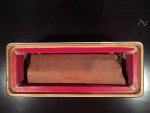Are, or were, there any popular non-Russian accordions with a bass sordina, or some similar mechanism for softening the bass side?
I know some bayans have this and even some garmons do too:
In that video it makes a big difference to the strength of that garmons bass. I suppose this takes the place of not having much in the way of bass registers and if you had a way of selecting fewer reeds, you could probably save some air too.
I know some bayans have this and even some garmons do too:
In that video it makes a big difference to the strength of that garmons bass. I suppose this takes the place of not having much in the way of bass registers and if you had a way of selecting fewer reeds, you could probably save some air too.

